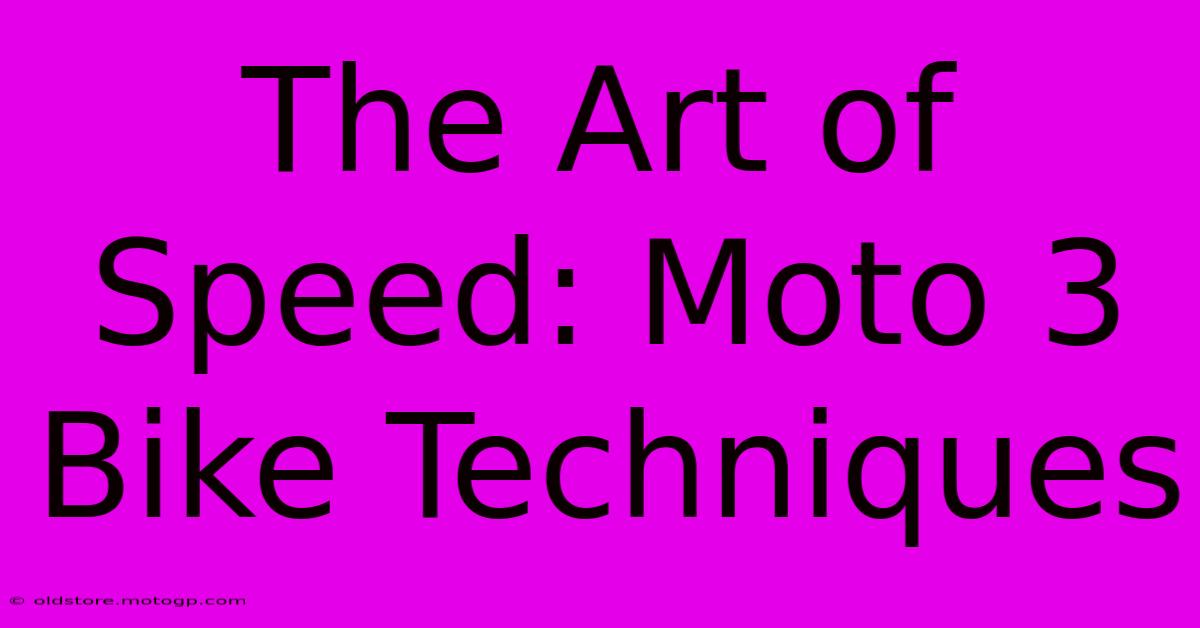The Art Of Speed: Moto 3 Bike Techniques

Table of Contents
The Art of Speed: Moto3 Bike Techniques
Moto3 racing is a spectacle of raw speed and precision, a thrilling display of young talent pushing lightweight machines to their absolute limits. Understanding the techniques employed by these riders is key to appreciating the artistry and athleticism involved. This article delves into the key techniques that separate the Moto3 frontrunners from the pack.
Mastering the Machine: Bike Setup and Rider Position
The Moto3 bike, a nimble 250cc beast, demands a specific setup and riding style. Success hinges on a perfect synergy between rider and machine.
Optimal Bike Setup:
- Suspension Tuning: Fine-tuning the suspension is crucial. Moto3 riders work closely with their mechanics to achieve the perfect balance between stability under braking, agility through corners, and comfort over bumps. This involves adjustments to spring preload, compression damping, and rebound damping, all tailored to the specific track characteristics.
- Aerodynamics: Even small aerodynamic gains can make a significant difference at Moto3 speeds. Riders and teams meticulously analyze the bike's aerodynamics, often employing winglets and fairings designed to minimize drag and maximize downforce in critical sections of the track.
- Tire Selection: Tire choice is paramount. Different compounds offer varying levels of grip and wear resistance, making the selection process critical based on track temperature, expected weather conditions, and race strategy.
Rider Body Positioning:
- Aerodynamic Tuck: Maintaining an aerodynamic tuck minimizes drag, allowing the rider to maintain higher speeds on straights. This position involves leaning forward, tucking the elbows and knees in, and keeping the head low.
- Weight Transfer: Precise weight transfer is vital for both acceleration and braking. Shifting the rider's weight forwards during braking helps transfer weight to the front tire, enhancing stopping power. Conversely, shifting weight backwards during acceleration improves traction on the rear tire.
- Smooth Inputs: Moto3 riders are masters of smooth inputs, applying throttle, brakes, and steering inputs progressively and smoothly. Jerky movements disrupt the bike's balance, leading to instability and slower lap times.
Cornering Techniques: Precision and Flow
Cornering in Moto3 is a ballet of controlled slides and precise line selection. Riders navigate corners with an almost supernatural fluidity.
Line Selection:
- Finding the Apex: Identifying the optimal racing line, including the precise apex of each corner, is crucial. This involves analyzing the track's camber and identifying the point where the rider can achieve the highest cornering speed while maintaining stability.
- Trail Braking: Moto3 riders are masters of trail braking, applying the brakes while simultaneously turning into the corner. This technique allows them to carry more speed into the corner and achieve a tighter racing line.
- Corner Exit: Smooth and efficient corner exits are essential for maximizing acceleration. Riders smoothly apply the throttle as they exit the corner, progressively increasing the throttle opening as grip allows.
Advanced Cornering Techniques:
- Counter Steering: Counter steering, where the rider subtly pushes the handlebar in the direction they want the bike to turn, is a fundamental skill.
- Body Position: Riders use their body weight to influence the bike’s lean angle and adjust its balance, crucial for maintaining stability at high lean angles.
- Smooth Transitions: seamless transitions between braking, cornering, and acceleration are key to maintaining consistent speed and optimal lap times.
Overtaking Maneuvers: Courage and Precision
Overtaking in Moto3 is a high-stakes game of inches and split-second decisions.
Strategic Overtaking:
- Finding the Opportunity: Riders look for gaps and exploit weaknesses in their opponents' racing lines.
- Precise Positioning: Executing a clean overtake requires precision in terms of timing and bike placement.
- Awareness: Maintaining awareness of surrounding riders is vital to anticipate their moves and avoid collisions.
Conclusion: The Pursuit of Perfection
Moto3 racing demands a perfect blend of skill, technique, and physical fitness. The riders' mastery of bike setup, rider position, cornering techniques, and overtaking maneuvers showcase the high level of skill involved in this thrilling motorsport discipline. Understanding these techniques provides a deeper appreciation for the artistry and athleticism displayed in every Moto3 race. The pursuit of perfection is a constant challenge, and the constant quest for improvement is what fuels this exciting category of racing.

Thank you for visiting our website wich cover about The Art Of Speed: Moto 3 Bike Techniques. We hope the information provided has been useful to you. Feel free to contact us if you have any questions or need further assistance. See you next time and dont miss to bookmark.
Featured Posts
-
Cota Lot A Your Key To A Happier Life
Feb 18, 2025
-
Moto Gp Sprint Results The Future Of Moto Gp Racing
Feb 18, 2025
-
Own The Track Ex Moto Gp Bike Seeking New Owner
Feb 18, 2025
-
Yamaha Moto Gp Team Under Pressure
Feb 18, 2025
-
Moto2 Specifications A Deep Dive Into Performance
Feb 18, 2025
